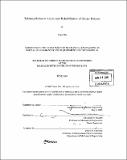| dc.contributor.advisor | Alexander H. Slocum. | en_US |
| dc.contributor.author | Shu, Yuan, 1983- | en_US |
| dc.contributor.other | Massachusetts Institute of Technology. Dept. of Mechanical Engineering. | en_US |
| dc.date.accessioned | 2006-05-15T20:39:45Z | |
| dc.date.available | 2006-05-15T20:39:45Z | |
| dc.date.copyright | 2005 | en_US |
| dc.date.issued | 2005 | en_US |
| dc.identifier.uri | http://hdl.handle.net/1721.1/32926 | |
| dc.description | Thesis (S.B.)--Massachusetts Institute of Technology, Dept. of Mechanical Engineering, 2005. | en_US |
| dc.description | Includes bibliographical references. | en_US |
| dc.description.abstract | The aim of this project was to design and build a tabletop robot that could move the arm of a patient with limited motor function around on a table in any given trajectory to aid the patient in regaining function. The design that resulted from bench level experiments was that of an arm brace mounted to a moving base. The base needed to be omni directional to accommodate all possible trajectories of motion, the arm brace needed to be able to move vertically as well as be flexible enough to accommodate yaw, pitch and roll of the forearm. After choosing a three-wheeled design using TransWheelsTM, the base of the robot was built and programmed by Adam Kraft. The arm brace, which I designed and built, had a rack and pinion setup with a variable voltage regulator to control its vertical motion and a foam and linear spring combination to allow for yaw, pitch and roll while still providing for support. Testing of the prototype proved extremely valuable in refining the requirements of the robot as well as the design. Issues that were discovered during testing of the robot included drift of the robot, the inability to orient the robot the same each time, the slipping of the pinion on the rack if too much downward force is applied to the arm brace and the stiffness of the arm brace during yaw, pitch and roll. | en_US |
| dc.description.abstract | (cont.) Several suggestions were made for possible solutions to the issues, all which seem very feasible to implement. As it is the robot can only move the patient's arm, the patient cannot move the robot since the motors are not back-drivable. This is an impediment in allowing the patient to initiate movement, which is a critical part of therapy. Solutions were proposed that are worth further examination to determine their feasibility. In addition, with a few changes, the robot act as a guide to move a patient's passive arm along a preprogrammed trajectory to aid the patient in performing tasks such as reaching. Even if the robot is unable to match its initial goal, it has great potential to become a valuable asset to stroke patients with limited arm motor function. | en_US |
| dc.description.statementofresponsibility | by Yuan Shu. | en_US |
| dc.format.extent | 32 leaves | en_US |
| dc.format.extent | 2159516 bytes | |
| dc.format.extent | 2158414 bytes | |
| dc.format.mimetype | application/pdf | |
| dc.format.mimetype | application/pdf | |
| dc.language.iso | eng | en_US |
| dc.publisher | Massachusetts Institute of Technology | en_US |
| dc.rights | M.I.T. theses are protected by copyright. They may be viewed from this source for any purpose, but reproduction or distribution in any format is prohibited without written permission. See provided URL for inquiries about permission. | en_US |
| dc.rights.uri | http://dspace.mit.edu/handle/1721.1/7582 | |
| dc.subject | Mechanical Engineering. | en_US |
| dc.title | Tabletop robot to aid in arm rehabilitation of stroke patients | en_US |
| dc.type | Thesis | en_US |
| dc.description.degree | S.B. | en_US |
| dc.contributor.department | Massachusetts Institute of Technology. Department of Mechanical Engineering | |
| dc.identifier.oclc | 62775226 | en_US |
